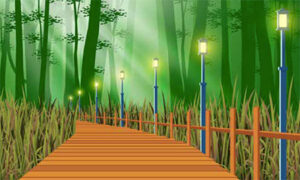Careful design using both light and darkness can ease the path
By Jane Slade
 Within a period of about 150 years, rail transportation in the U.S. sparked a revolution that swept the nation and then rather quickly got swept away by other forms of transportation and technology. In their original incarnation, rail lines broke down vast distances for industries and people, making a new way of life possible. As train travel declined in the late 20th century, these corridors at first fell by the wayside. Largely due to advocacy by residents and government organizations, however, these grooves in the Earth have begun to be reclaimed and repurposed as trails.
Within a period of about 150 years, rail transportation in the U.S. sparked a revolution that swept the nation and then rather quickly got swept away by other forms of transportation and technology. In their original incarnation, rail lines broke down vast distances for industries and people, making a new way of life possible. As train travel declined in the late 20th century, these corridors at first fell by the wayside. Largely due to advocacy by residents and government organizations, however, these grooves in the Earth have begun to be reclaimed and repurposed as trails.
Growing up in upstate New York, I vividly remember passing such a train track on my way to school and never once seeing a train. There was an eeriness and a haunting to this unused space, somehow connecting us to the past and unknown places out of view, and yet it was this very gap in space that allowed me to know the natural beauty of that part of the landscape.
According to the Rails-to-Trails Conservancy, over 24,000 miles of rail lines have been converted into about 2,200 unique trails in the U.S., with over 9,000 miles still to be potentially converted. This emerging network of greenspace is an immense opportunity to invent an entirely different network of infrastructure between us, one deeply rooted in nature, vastness, balance and beauty.
The need for a connection to the natural landscape has never felt more profound as it has during the 2020 global pandemic. Rail trails support human wellbeing by providing space for exercise, sustainable forms of
transportation, increased connection to nature, compassionate connection to wildlife within natural habitats, and in general, equitable access to recreation for people of all ages, abilities and backgrounds.
Yet, it must be noted that these benefits require the least intervention upon nature as possible. Rail trails pass through vastly different settings, from inner cities to untouched and wild lands. Our treatment of these corridors must reflect the specific needs of the places they pass through and requires a sober look at where and how much light is truly needed, especially regarding natural landscapes.
Currently, light pollution continues to increase all around us. According to the International Dark-Sky Association, satellite images of the Earth over a five-year period show a 2% increase of light pollution each year. We are slowly disconnecting all living things from the natural daylight cycle, the map of the stars, and the natural syncopation of all life on Earth. Vanquishing light pollution will be of critical importance in the post-pandemic era of climate-focused design.
RAIL TRAILS CAN BECOME A MODEL for outdoor lighting strategies because they create a shared experience across vast landscapes and communities. This immense web is a platform to broadly reset expectations toward a more sustainable outdoor lighting model, pivoting around one central point—to restore nightly darkness.
We must first confront the cognitive dissonance within our thought process as we begin to reframe our lighting design strategies. At once we practice that more light is better and safer while simultaneously being horrified by satellite photographs of light pollution. We must also confront the opposing concepts of liability and the fact that the planet
has never been brighter. Yet, it is possible to light for human activity and limit impact upon wildlife. In fact, it is completely within us to solve light pollution, and to do it with excellence. The block is not that it is impossible; it is in our thinking and design practices. We must entirely shift our design philosophy to be inclusive of darkness, and to design with it. Darkness is not only needed, but it is beautiful.
Recent advancements in lighting controls mean that we can get extremely specific with our use of light, curating down to a single fixture. For instance, we can turn lights out in zones, like park lighting after hours. We can also easily dim specific lights that are causing a nuisance for residents and keep lights off until needed with occupancy sensors. In the future, our communities will declare a period of cultural nighttime and design specific lighting plans for this period. This specificity lets lighting designs address the individuality of each community, street, landscape, habitat and season, making it completely possible to better support the circadian rhythms and well-being of all living things.
Additionally, as we offer access to stunning vistas previously known only to freight trains and wildlife, we should deeply consider complete darkness on those long and wild stretches in the same way that we do not illuminate hiking paths on mountains. Models of sustainability must include keeping a certain proportion of our land forever wild, and light is yet another way in which we take habitat from wildlife. When lighting in natural areas is critical for human safety, solar lighting avoids habitat disruption caused by trenching for wiring. Fixtures can be planted like a tree and programmed to remain off during parts of the night or year.
As rail trails pass through areas of higher density, it will be important to develop outdoor lighting plans that make communities feel safe and supported. Lighting for human safety is of utmost importance and a high priority for the spending of nightly lumens, especially for areas of concern for pedestrians and bicyclists. Community engagement is a key step in this process, as each community has different needs and responds differently to light. Lighting controls can make communities feel even more supported by offering the chance to amend and improve upon lighting plans over time, as feedback from residents can be applied to decrease or increase light levels.
There is an expression: “If I have a hammer, then everything is a nail.” To reduce planetary light levels, it will be necessary to design not just with light, but with the concepts of darkness and the natural daylight cycle too. The ease of LEDs has made it all too easy to blare light constantly, and this has spread across our landscapes in a fire of light addiction, robbing wildlife of the natural daylight cycle. While more light may feel safer to us, the health of wildlife will be one of the most profound indicators of human health in the coming decades.
THE IMPACTS OF LIGHT POLLUTION upon the planet could be greatly reduced simply by shifting awareness. The expansive nature of rail trails, both physically and meditatively, offers an immense platform for sustainability. Darksky advocacy in communities is critical to reveal the hidden consequences of light at night and that it has ghastly impacts on animal and plant behaviors, from reducing pollination to disrupting migration, reproduction and natural selection. Up to one billion birds die due to fatal flight into buildings each year in North America. Right now, the specific issue of light pollution is caught in the weeds of climate change awareness, yet it may be one of the most easily solved issues. Light pollution goes away instantaneously when you turn the lights out. In the words of Maya Angelou, “Do the best you can until you know better. Then when you know better, do better.”
In the post-pandemic era of outdoor lighting design, we must be as intentional as possible about where, when and how much light we shine at night, leaving selected areas preserved and protected in darkness. Additionally, refining codes and guidelines to more specific applications will allow an even finer tuning of light levels. Lastly, installing lighting controls will empower communities with autonomy and the ability to achieve a more sustainable light level.
The network of rail trails across the U.S. holds the potential of becoming a new transportation revolution altogether, uniting the country with a sustainable network of trails based in principles of equity and sustainability. This new model of greenspace is an opportunity to reinvent and employ more sustainable lighting design concepts, and to get specific for each landscape, each community and each application. In their reincarnation, rail trails hold the promise of being inclusive of all people, plants and creatures, continuing to break down vast distances for people and making a new way of life possible.


